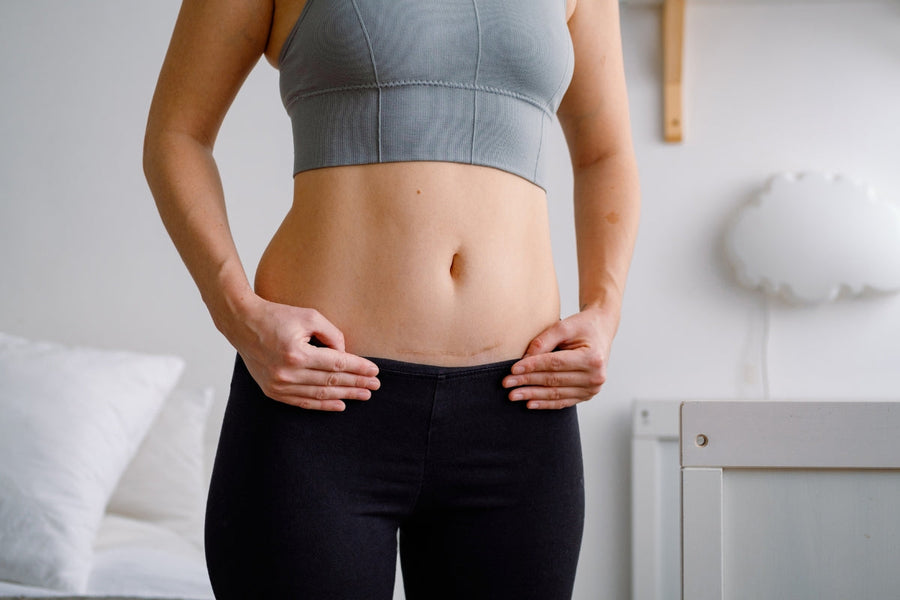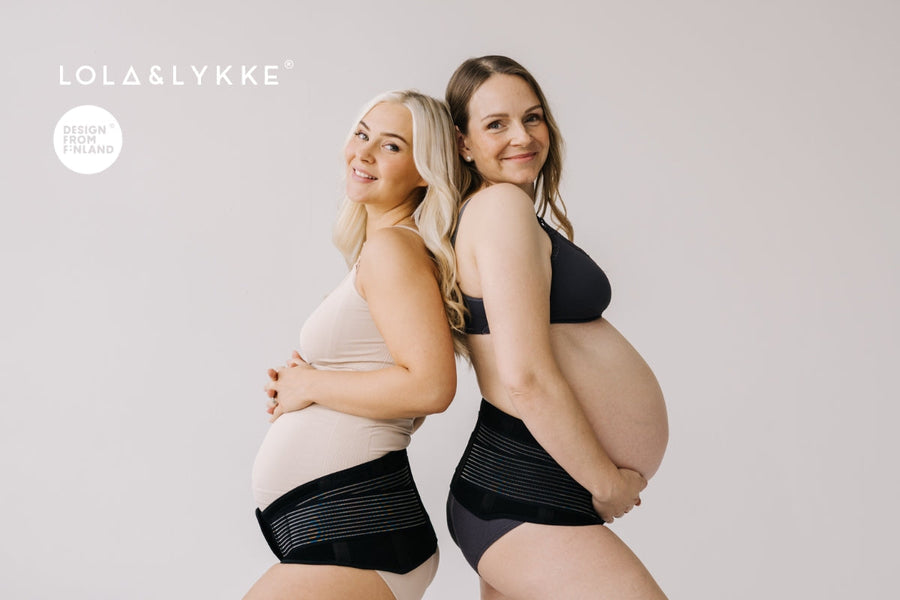From conception to a full-grown baby bump, your body undergoes a lot of changes through pregnancy. So it should come as no surprise that our bodies need some extra support along the way! Pregnancy aches and pains can present at different times and in different ways for expecting mums, which is why the tailored support an abdominal band for pregnancy can provide is essential for feeling yourself again.
Spoiler alert: there is no exact time or pain threshold to wait for, to start wearing a pregnancy support belt.
What Is an Abdominal Band for Pregnancy (And What Does It Actually Do)?
A support belt for pregnant women is often referred to as an abdominal band for pregnancy or a pregnancy support belt. Both names are talking about support bands and pregnancy belts. Throughout this guide, you’ll see the names used interchangeably.
Abdominal bands for pregnancy are different to compression belts. Rather than compressing the midsection, they support it. Compression garments would not be safe to wear during pregnancy because of the pressure they create against your abdomen. A support belt alleviates the pressure your baby bump can put on areas of the body, such as your back, hips, pelvis, and core.
Pregnancy support belts have lots of other key benefits that have helped mums overcome common pregnancy symptoms, such as:
-
Relieves back, pelvic, and hip pain
-
Encourages improved posture
-
Supports your core muscles as your bump grows
-
Improves mobility and confidence in movement
-
Eases pressure on your bladder and spine
-
Exercise safely with extra support
Trimester-by-Trimester Breakdown: When Should You Start Wearing a Pregnancy Support Belt
Support looks different for every pregnancy, and it can depend on so many factors. But ultimately, your comfort is the priority for staying active and enjoying your pregnancy through all the stages.
🔸 First Trimester: Usually Not Necessary, But There Are Exceptions
In most cases, mums-to-be do not need to wear a pregnancy support belt in the first trimester (0 - 12 weeks) because their baby bump will only just be starting to show towards the end of this trimester. Sometimes, if mums have had pre-existing conditions, e.g. back injury, then wearing an abdominal band for pregnancy early on can be helpful.
There is no harm in wearing a pregnancy belt early because it also helps to support your spine and encourages better posture, particularly if you’re sitting down for a long time. If you’re not sure whether a pregnancy support belt is beneficial for you at this time, consult a maternal health professional for advice.
🔸 Second Trimester: The Ideal Time to Start for Most Mums
During the second trimester, you start to really see the growth that is happening inside you! Your baby bump will become more prominent, and this is when other pregnancy symptoms will start, and an abdominal band for pregnancy can help.
As your baby bump grows, you slowly learn how to move your body differently, slowly, and with confidence, which is made much easier when you’re wearing a pregnancy support belt. The weight of your bump is supported and alleviates common pregnancy aches and pains in your lower back, hips, and pelvis. Ideally, you will want to choose a structured belly band that grows with you and is adjustable throughout the trimesters.
🔸 Third Trimester: More Relief, More Structure
By the third trimester, your baby will be gaining up to 450g in weight each week. That’s like carrying half a bag of flour on your tummy extra each week! The extra weight that you and your baby are gaining can put a lot of strain and pressure on your body, which is why pregnant women in the later stages of pregnancy “waddle” when they walk and arch their backs to compensate.
Managing discomfort at this point is crucial to staying mobile and reducing any pain. A pregnancy support belt can help mums to continue everyday tasks, even simple things like getting in and out of a chair, without having to move and twist awkwardly.
For some mums, pregnancy pain is more intense because they have symptoms of…
An abdominal band for pregnancy gently lifts your baby bump and supports the extra weight, which then alleviates pain or discomfort on your back, hips, and pelvis. A pregnancy support band with dual-compression straps means you can tailor the support where you need it most and adjust it as necessary.
How to Know It’s Time: Signs You Might Benefit from a Pregnancy Belt
When you go to your midwife appointments throughout your pregnancy, they will check in on how you’re feeling and how to manage any pregnancy symptoms you might be experiencing. Sometimes, having the reassurance from your healthcare professional can be the friendly nudge you need to accept extra support, like wearing a pregnancy belt.
Signs to spot where an abdominal band for pregnancy can help:
-
Lower back pain or SI joint pain
-
Your belly feels like it’s pulling you forward
-
Struggling with standing or walking
-
Poor posture from desk work or long hours on your feet
You don’t have to struggle through pregnancy. There are maternity products, like support bands, that are designed to alleviate common pregnancy symptoms so you can carry on your day as normal, comfortably.
Tips for Wearing a Pregnancy Support Belt Safely
To get the best from your belly band, there are some do’s and don’ts that are key to follow for your comfort, but most importantly, for you and your baby’s safety too. As talked about before, pregnancy support belts are different to compression belts because they support rather than constrict. Therefore, it’s important not to fasten your pregnancy belt too tightly; the idea is to gently lift rather than squeeze.
Here are some insightful tips shared by our belly band-loving mummas:
-
If your skin is more sensitive, wear the pregnancy belt over a thin clothing layer to protect the skin
-
Start with short sessions, gradually increasing comfort time
-
Combine with light stretches and mindful posture habits
-
Wear a hot or cold pack with your pregnancy belt for added relief
|
DO
|
DON’T
|
|
Wear your pregnancy belt for gentle exercises and stretches
|
Wear a pregnancy support band while you sleep
|
|
Wear during long periods of sitting or standing
|
Fasten the pregnancy belt too tight
|
|
Check you have the correct size belly band
|
Wear your belly band beyond the instructed time-frame noted in the user manual
|
Choosing the Right Pregnancy Support Belt for Each Stage
Each trimester comes with its challenges and delights, and it’s important to prioritise your comfort and self-care throughout. When choosing an abdominal band for pregnancy, keep in mind what features you seek in a support band and scan the reviews for honest feedback from real mums before purchasing.
In the first trimester, you may not need a pregnancy belt, but for those who do, look for a belly band that supports your body through all stages of pregnancy, including the early weeks. As your bump grows, you will be looking for a more structured support that can alleviate common pregnancy pressure points to increase your comfort and mobility.
Look out for an abdominal band for pregnancy with features like…
-
Made from soft, breathable fabrics like bamboo viscose with high elasticity
-
Ergonomic design made by physiotherapists and maternal experts in their field
-
Dual-band compression straps to adjust support zones
-
Hot/cold therapy pouch on the lower back for added instant relief
-
Can be worn under or over your clothes
-
Customised sizing options to fit all body shapes
-
Tested and reviewed by mums and awarding bodies
We recommend: Lola and Lykke Core Relief Pregnancy Support Belt, which ticks all these boxes!
It’s Not Just About the Trimester - It’s About Listening to Your Body
You don’t need to wait until you're hurting and uncomfortable to get a pregnancy support belt. Regardless of which trimester or week you are at, you can benefit from wearing an abdominal band for pregnancy if symptoms start to arise. Basically, if you start to feel your mobility and pain limit what you can do, try a belly band.
Shop the pregnancy belt to support your growing baby bump and wave goodbye to the pregnancy aches and pains. And if you want to be super organised, add our Postpartum Core Restore Support Band to your hospital bag for added support for your delicate body after pregnancy and labour.



